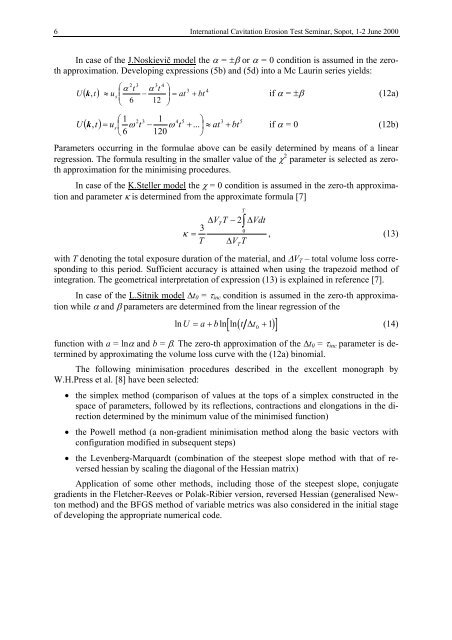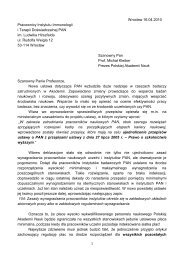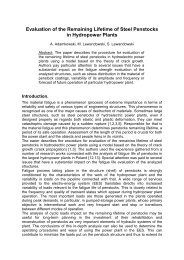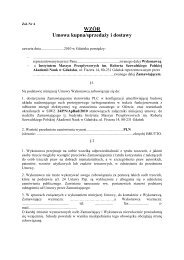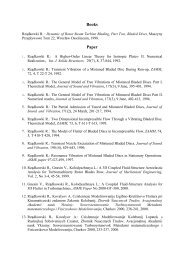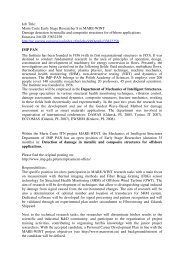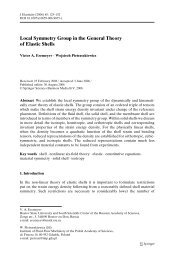Phenomenological models of cavitation erosion kinetics
Phenomenological models of cavitation erosion kinetics
Phenomenological models of cavitation erosion kinetics
- No tags were found...
You also want an ePaper? Increase the reach of your titles
YUMPU automatically turns print PDFs into web optimized ePapers that Google loves.
6 International Cavitation Erosion Test Seminar, Sopot, 1-2 June 2000In case <strong>of</strong> the J.Noskievič model the α = ±β or α = 0 condition is assumed in the zerothapproximation. Developing expressions (5b) and (5d) into a Mc Laurin series yields:2 3 3 4⎛αt α t ⎞3 4U ( k , t) ≈ u ⎜⎟s − = at + bt6 12if α = ±β (12a)⎝⎠⎛ 1 2 3 1 4 5 ⎞ 3 5U ( k , t) = us ⎜ ω t − ω t + ... ⎟ ≈ at + bt if α = 0 (12b)⎝ 6 120 ⎠Parameters occurring in the formulae above can be easily determined by means <strong>of</strong> a linearregression. The formula resulting in the smaller value <strong>of</strong> the χ 2 parameter is selected as zerothapproximation for the minimising procedures.In case <strong>of</strong> the K.Steller model the χ = 0 condition is assumed in the zero-th approximationand parameter κ is determined from the approximate formula [7]∆VTT− 2 ∆Vdt30κ =, (13)T ∆VTwith T denoting the total exposure duration <strong>of</strong> the material, and ∆V T – total volume loss correspondingto this period. Sufficient accuracy is attained when using the trapezoid method <strong>of</strong>integration. The geometrical interpretation <strong>of</strong> expression (13) is explained in reference [7].In case <strong>of</strong> the L.Sitnik model ∆t 0 = τ inc condition is assumed in the zero-th approximationwhile α and β parameters are determined from the linear regression <strong>of</strong> the[T(T∫ln U = a+ bln ln t ∆t0+ 1)] (14)function with a = lnα and b = β. The zero-th approximation <strong>of</strong> the ∆t 0 = τ inc parameter is determinedby approximating the volume loss curve with the (12a) binomial.The following minimisation procedures described in the excellent monograph byW.H.Press et al. [8] have been selected:• the simplex method (comparison <strong>of</strong> values at the tops <strong>of</strong> a simplex constructed in thespace <strong>of</strong> parameters, followed by its reflections, contractions and elongations in the directiondetermined by the minimum value <strong>of</strong> the minimised function)• the Powell method (a non-gradient minimisation method along the basic vectors withconfiguration modified in subsequent steps)• the Levenberg-Marquardt (combination <strong>of</strong> the steepest slope method with that <strong>of</strong> reversedhessian by scaling the diagonal <strong>of</strong> the Hessian matrix)Application <strong>of</strong> some other methods, including those <strong>of</strong> the steepest slope, conjugategradients in the Fletcher-Reeves or Polak-Ribier version, reversed Hessian (generalised Newtonmethod) and the BFGS method <strong>of</strong> variable metrics was also considered in the initial stage<strong>of</strong> developing the appropriate numerical code.


